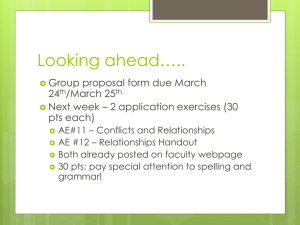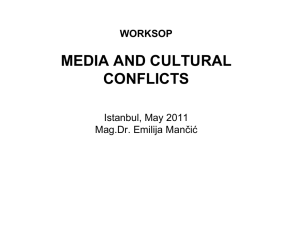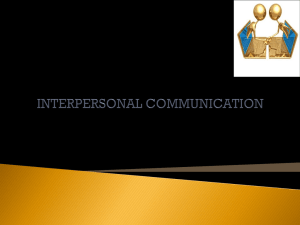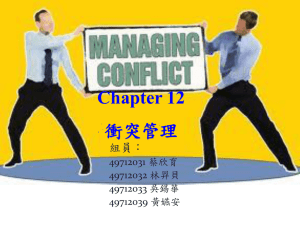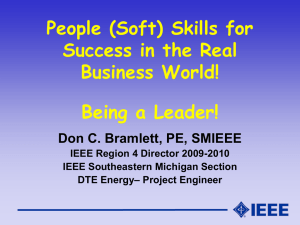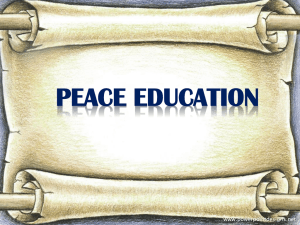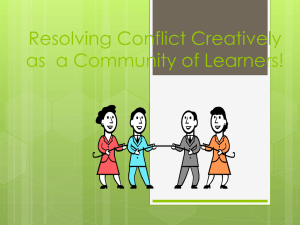Chapter 9: Communicating Power and Conflict
advertisement
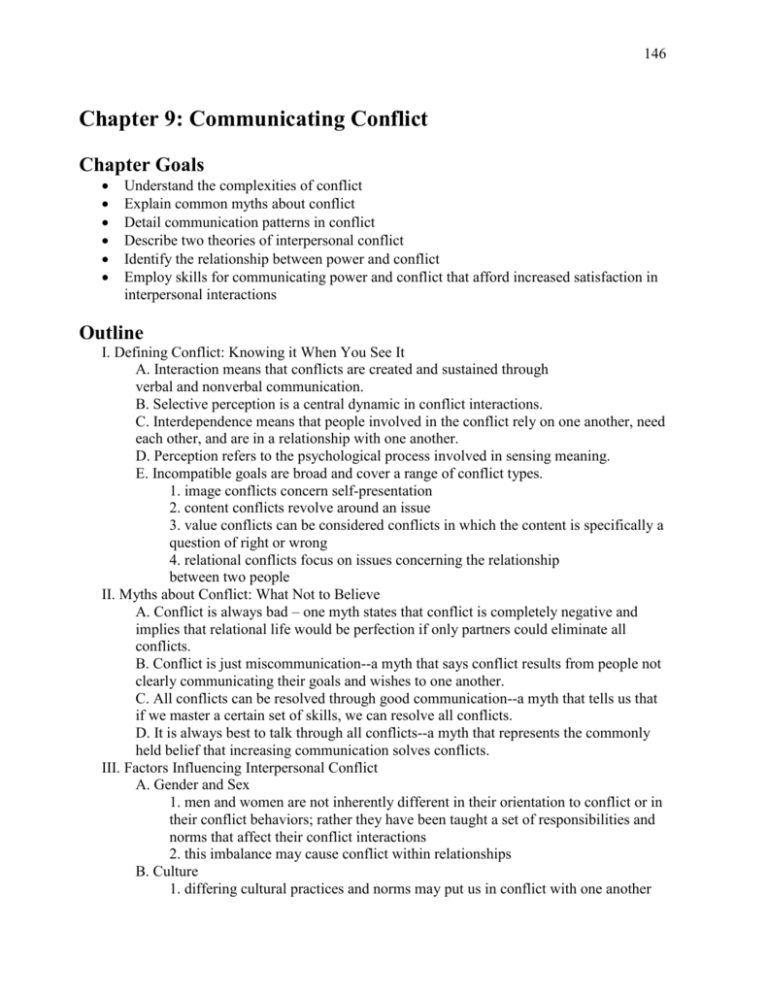
146 Chapter 9: Communicating Conflict Chapter Goals Understand the complexities of conflict Explain common myths about conflict Detail communication patterns in conflict Describe two theories of interpersonal conflict Identify the relationship between power and conflict Employ skills for communicating power and conflict that afford increased satisfaction in interpersonal interactions Outline I. Defining Conflict: Knowing it When You See It A. Interaction means that conflicts are created and sustained through verbal and nonverbal communication. B. Selective perception is a central dynamic in conflict interactions. C. Interdependence means that people involved in the conflict rely on one another, need each other, and are in a relationship with one another. D. Perception refers to the psychological process involved in sensing meaning. E. Incompatible goals are broad and cover a range of conflict types. 1. image conflicts concern self-presentation 2. content conflicts revolve around an issue 3. value conflicts can be considered conflicts in which the content is specifically a question of right or wrong 4. relational conflicts focus on issues concerning the relationship between two people II. Myths about Conflict: What Not to Believe A. Conflict is always bad – one myth states that conflict is completely negative and implies that relational life would be perfection if only partners could eliminate all conflicts. B. Conflict is just miscommunication--a myth that says conflict results from people not clearly communicating their goals and wishes to one another. C. All conflicts can be resolved through good communication--a myth that tells us that if we master a certain set of skills, we can resolve all conflicts. D. It is always best to talk through all conflicts--a myth that represents the commonly held belief that increasing communication solves conflicts. III. Factors Influencing Interpersonal Conflict A. Gender and Sex 1. men and women are not inherently different in their orientation to conflict or in their conflict behaviors; rather they have been taught a set of responsibilities and norms that affect their conflict interactions 2. this imbalance may cause conflict within relationships B. Culture 1. differing cultural practices and norms may put us in conflict with one another 147 2. culture affects our conduct of interpersonal conflict in myriad ways IV. Communication Patterns in Conflict A. Symmetrical escalation exists when each partner chooses to increase the intensity of the conflict. B. Symmetrical withdrawal means that when conflict occurs, neither partner is willing to confront the other. C. Pursuit-withdrawal/Withdrawal-pursuit, unlike the previous two, are asymmetrical and mean that the behavior of one partner is complemented by the other’s behavior rather than one partner mirroring the behavior of another. D. Symmetrical negotiation is a positive pattern where each partner mirrors the other’s negotiating behaviors. V. The Dark Side of Interpersonal Conflict A. Bullying is where the abuse is persistent and the person being bullied finds it very difficult to defend himself or herself. 1. bullying often takes place in situations where there is a distinct power difference. 2. isolating, nitpicking, excessively criticizing, humiliating, and physical abuse can all be characteristics of bullying. B. Violence and Aggression 1. verbal and nonverbal acts geared to hurt or cause suffering. 2. in communication discipline, most research on violence has focused on the family. VI. Explaining Conflict through Theory A. Satir’s four-part model includes the critical parts of any conflict: you, me, the context, and the subject. B. Cupach & Canary model conflict as a process that occurs in the following episodes: distal context, proximal context, conflict interaction, proximal outcomes, and distal outcomes. VII. The Relationship of Conflict to Power A. Using Power: 1. direct application 2. direct and virtual use of power 3. indirect application 4. hidden use B. Sex Differences: although sex role stereotypes in the US suggest that husbands have more power in decision-making than their wives, one study suggests that sex differences do not operate stereotypically in marital decision-making. C. Empowerment, or helping to actualize people’s power. VIII. Choices for Conflict Management: Working it Out A. Lighten up and reframe is a technique that includes staying in the present and acknowledging that you have heard what your relational partner just said. B. Presume good will and express good will means that you go into each conflict interaction believing that you and your partner both want to come to a constructive resolution. C. Ask questions after you have both had a chance to speak. 148 D. Listen and remember to practice all of the behaviors associated with effective listening. E. Practice cultural sensitivity and be mindful and tune into your own culture’s norms and assumptions first before evaluating others (Ting-Toomey& Oetzel, 2001). Terms for Review active conflict aftermath coercive power computing content conflicts direct and virtual use of power direct application of power distracting empowerment expert of information power hidden power image conflict indirect application of power initial awareness interaction interdependence interpersonal conflict legitimate power personal issues persuasive power placating pouncing power prior conditions public issues pursuit-withdrawal referent power reframe relational conflicts relational messages resolution reward power symmetrical escalation symmetrical negotiation symmetrical withdrawal value conflicts withdrawal-pursuit 146 Student Activities 1. Directions: Match the types of conflict with the dialogues that follow. (Answers are at the end of the chapter.) A. image conflict B. content conflict C. value conflict D. relational conflict ______Grace: I thought the capital of Australia was Sydney. Lee: I’m sure it’s Canberra. Let’s look it up. ______ Steven: You shouldn’t be drinking, Carla! Carla: I’m 22 years old, Steven. Stop treating me like your baby sister. Steven: You are my baby sister. ______ Henry: I don’t think the ex-governor of New York should have had to resign because he used a call girl. Men have affairs all the time. Andrea: That doesn’t make it right! Prostitution is still illegal and he was in an influential and visible position of authority. ______ Ricky: Why do you have to go out with people after work when I’m home waiting for you? Don’t you like spending time with me anymore? Cheryl: Of course I like spending time with you. We’ve been going out after work every Friday since before I met you. 2. Directions: Pay close attention to your interpersonal conversations for the next few days. Did you run into any conflict? What type of conflict? Were there any sources of power involved? Fill out the chart below as much as possible. Conflict? Type of conflict Source of power Roommate: Friend: Parent: Professor: 3. Directions: Watch a sitcom or drama. Was there conflict between any of the characters? Was it resolved? What caused the conflict? Did they perceive the same situation differently? How realistically do you think their conflict was handled? Write down your answers. Describe the conflict to a classmate and discuss your perceptions. 147 4. Directions: For each of the following situations write whether or not the resulting statement about communication and conflict is a myth (fiction) or a truth (fact). (Answers appear at the end of this chapter.) ________ Sue, a high school senior, wants to go to a party at the college where her cousin, Caitlin, goes to school. Sue’s parents tell her she can’t because they’re not comfortable with her being at a party where there will be alcohol available and no adults to supervise. Sue thinks her parents don’t trust her and doesn’t know why she bothers trying to talk to them. When Sue calls Caitlin to tell her she can’t go, she complains that it is impossible to try and communicate with her parents. The girls decide it is a miscommunication based on their different generations. _________ Sue can’t decide where she wants to go to college. Her parents want her to go to the same school as Caitlin because it’s not too far from their home and they also went to that college and liked it very much. Sue really wants to go out of state and study linguistics which they don’t offer at the school Caitlin attends. Sue’s parents believe that once she gets there she’ll love it. Sue’s parents believe this is an example of poor communication and they try to resolve the issue through better communication. __________ Lydia and Wendy have been trying to get together for ages. They finally agree on this Saturday. Lydia says that Saturday would be great but she has a lot going on so they should meet at 8:00. Lydia, who always gets up early to go running, meant 8 in the morning but Wendy, who hates getting up early assumed she meant 8 p.m. When they realized they both assumed different things, they laughed and decided it was a big miscommunication. Interactive Activities 9.1: Conflict in Context http://www.crinfo.org/gcsearch/news/news_preconfigured.jsp For a number of links about conflict at the local, national, and international levels, explore this site, News about Types of Conflict. 1. For class, select one area of conflict you are interested in exploring and locate a relevant article. 2. Bring the article to class or summarize it to inform your classmates of a current issue about conflict. 148 3. See if you can integrate some of the terms and concepts from Chapter 9 of your textbook into your presentation. What type of conflict can you identify? What, if anything, is being done to help resolve the conflict? Summary: The page of the CRInfo Project website is an excellent resource for anyone interested in researching conflict. It offers links to websites, articles, and news stories covering a variety of conflict issues. 9.2: Causes of Conflict http://www.geocities.com/Athens/Forum/1650/htmlcausesofconflict.html In addition to the types of conflict, take a look at some additional causes of conflict. 1. In this website, conflict is divided into three major categories: conflicts that arise from communication, organizational structure, and personal variables. Click on the forward arrow at the top or bottom of the page to go to the next site, where destructive versus constructive conflict is discussed. 2. Can you think of an example of constructive conflict? How was the conflict helpful? Summary: The website Causes of Conflict provides information about the causes of conflict and the differences between constructive and destructive conflict. 9.3: Techniques for Resolving Conflict http://lifeesteem.org/wellness/wellness_conflict.html How we communicate in conflict situations is, in many ways, more important than the conflict. Take a look at the website Interpersonal Conflict and Effective Communication for more information about communication techniques to reduce conflict: diffusing, empathy, exploration, using I-statements, and stroking. 1. In class, break into groups of three or four. 2. Pick one of the techniques described on the website. Think of a conflict situation, then ask two members of the group to act out the conflict in front of the class, practicing the conflict 149 reduction technique your group has chosen. Ask one of the remaining members to describe for the class the conflict situation and the technique being used. Summary: The website Interpersonal Conflict and Effective Communication provides information about styles and approaches that can help you prevent, reduce, and resolve conflict. InfoTrac College Edition Activities 9.1: Gender and Conflict “Gender-Related Effects in Emotional Responding to Resolved and Unresolved Interpersonal Conflict” by Mona El-Sheikh, Joseph A. Buckhalt, and Stephanie L. Reiter Sex Roles: A Journal of Research, November 2000 To read a research study on gender and conflict, check out “Gender-Related Effects in Emotional Responding to Resolved and Unresolved Interpersonal Conflict.” 1. What do you think about the researchers’ findings? 2. Are they consistent with your past experiences when in conflict with men versus women? Summary: This study examines conflict issues and gender differences and roles. Based on the results of the study, men’s and women’s perception of conflict were similar, yet women differed from men in their emotional responses to conflict. In addition, the study showed that both conflict and resolution appear to have a greater impact on women. 9.2: Culture and Conflict “Cultural Influences on Emotional Responding: Chinese-American and European-American Dating Couples during Interpersonal Conflict” by Jeanne L. Tsai and Robert W. Levenson Journal of Cross-Cultural Psychology, September 1997 Culture influences the way a person views and responds to conflict. This research study, “Cultural Influences on Emotional Responding,” finds that in some areas, Chinese-Americans are consistent with European-Americans’ cultural expectations in terms of emotion in conflict but inconsistent with their expectations in other areas. 1. After reading the research presented, do your own investigation. Talk about conflict with your classmates and friends who are from different cultural backgrounds than your own. How do they respond to conflict? How do they respond emotionally during conflict? How were they raised to deal with conflict? 150 2. Discuss with them what they believe has influenced their response to conflict: culture, gender, society, or some other individual experience. Summary: This article reports on a study that compared the emotional responses of European American and Chinese American dating couples involved in interpersonal conflict. 9.3: Managing Conflict in Relationships “Relationships: How to Manage Conflict; Resolving Differences Should Be a Priority. Here’s How to Do It” by Stanley Ducharme Paraplegia News, March 2004 Read the article “Relationships: How to Manage Conflict” and outline the suggestions the author provides to constructively deal with conflict. 1. Upon review of the author’s suggestions, can you think of any suggestions of your own for dealing with conflict constructively? 2. What conflict management approaches work for you? Summary: This article discusses conflict in relationships and offers tips to manage conflict when it arises. 9.4: Conflict in Groups “Conflict Resolution—A Key Ingredient in Successful Teams” by Thomas K. Capozzoli Supervision, November 1999 When you work in a group or on a team, conflict often surfaces. Read the article “Conflict Resolution—A Key Ingredient in Successful Teams” to learn more about constructive conflict and the process for resolving conflict. 1. What has been your experience with conflict when working in groups? 2. What do you like about working in groups? What don’t you like? 151 3. If conflict has arisen in a group you’ve worked in, what did you do about it? 4. Did you follow any of the steps for resolving conflicts listed in the article? If not, do you think they would have helped in the situation you described in question 3? Summary: This article suggests that if conflict in work groups is appropriately managed, it can be constructive rather than destructive. Causes of conflict and the steps of conflict resolution are also discussed. Your Turn Journal Activity In your journal, note the times you engage in interpersonal conflict during a week. Record the following information about your conflicts: _ The persons involved _ The relationships between/among the persons involved _ The context surrounding the conflict _ The topic of the conflict _ A rating of how important that conflict was to you (not very important - 1 to very important - 7) _ A brief description of what was said during the conflict _ A rating of how satisfied you were with the conflict (not at all satisfied - 1 to very satisfied - 7) _ A brief explanation of how this conflict relates to the material in this chapter. If you’d like, you can use your student workbook to complete this activity. 152 Quiz True or False 1. Conflict is not always bad. (p.304) True or False 2. Sometimes people have conflict because they can’t agree whose goal is most important. (p.305) True or False 3. All conflicts can be resolved through good communication. (p. 311) True or False 4. The best thing to do when you encounter conflict is always to talk it out. (p. 311) True or False 5. There is little to no difference in how men and women are socialized to handle conflict. (p. 314) True or False 6. A person whose primary orientation is toward individualism might conflict with a person whose primary orientation is toward collectivism. (p. 315) True or False 7. When each partner mirrors the other’s negotiating behaviors, it’s called symmetrical negotiation. (p. 319) True or False 8. It is usually a bad idea to ask too many questions in a conflict situation. (p.330) True or False 9. Interpersonal conflict is easily avoidable and in fact infrequent for most people.(p. 303) True or False 10. Value conflicts focus on issues concerning the relationship between two people. (p. 308) True or False 11. The longer a couple is together, the more likely they are to experience serial conflict. (p. 309) True or False 153 12. When the emotional aspects of a conflict are disqualified and only the rational aspects are considered, this is called computing. (p. 323) True or False Multiple Choice Questions 1. Rachel really likes the roommate she was assigned at school. The only problem is that her roommate likes to have other friends visit late and listen to music while Rachel prefers to study late at night. This type of conflict has to do with: (p. 304) A. perception B. incompatible goals C. interdependence D. inconsideration 2. Audra is Harry’s supervisor. Several times this month, Harry has taken extra long lunch hours. Audra decides to say something about typing up a memo regarding late lunches to her assistant while Harry is filing something nearby. This use of power would best be considered: (p. 327) A. direct and virtual use of power B. indirect application of power C. mishandling of power D. hidden power 3. Satir’s four-part model is made up of: (p. 321) A. I, you, conflict, and power B. you, me, conflict, and power C. you, me, the context, and the subject D. you, me, the subject, and the object 4. The first episode in The Explanatory Process Model is the distal context, which refers to: (p. 323) A. the background B. the time of day C. the distance between the people involved D. the aftermath 5. When people disqualify the you in conflict, they respond in an aggressive manner without acknowledging the needs of the other person in the conflict. Satir called this: (p. 321) A. punishing B. pounding C. pulsing D. pouncing 154 6. Evan didn’t like it when his older sister referred to him as her baby brother in front of his friends because he felt it made him sound immature. This type of conflict is a(n): (p. 306) A. image conflict B. content conflict C. value conflict D. relational conflict 7. Samantha and her colleague, Gene, were working on a project together that was due the following morning. Samantha felt it was more important to get all of their facts and figures accurate before starting, while Gene was more concerned with the final product. This type of conflict can best be defined as an issue of: (p. 303) A. perception B. incompatible goals C. interaction D. stubbornness 8. When neither person wants to confront the other in a conflict, it’s a pattern of conflict called: (p. 317) A. symmetrical negotiation B. withdrawal-pursuit C. withdrawal-withdrawal D. symmetrical withdrawal 9. Colin is pretty sure his girlfriend Rebecca is cheating on him. He really wants to talk about their relationship and asks her repeatedly but Rebecca keeps making excuses and avoids talking about it. This communication pattern in conflict is called: (p. 317) A. symmetrical escalation B. symmetrical withdrawal C. withdrawal-pursuit D. pursuit-withdrawal 10. The last three times Simon and Billy went out, Simon forgot his wallet and Billy ended up paying for both of them. Rather than say anything to Simon, Billy started avoiding him. Simon soon stopped asking Billy if he wanted to go out and the relationship dissolved. This communication pattern is called: (p. 317) A. symmetrical escalation B. symmetrical withdrawal C. symmetrical negotiation D. pursuit-withdrawal/withdrawal-pursuit 155 11. A passive response, which cancels out one’s own position in a conflict, is called: (p. 322) A. placating B. pouncing C. computing D. distracting 12. Disqualifying the subject of a conflict by distracting both people in the conflict with behaviors such as laughing, crying, or changing the subject, is called: (p. 323) A. placating B. pouncing C. computing D. distracting 13. When Charlotte and Trey argue, Charlotte says she left her position at an excellent law firm just so Trey could pursue his dream of being a playwright. When Charlotte does this she implicitly sends a message that states she has power to define their relationship. This type of message is called: (p. 327) A. direct application of power B. direct and virtual use of power C. indirect application of power D. relational message 14. A type of power in which one person in a relationship suppresses or avoids decisions in the interest of one of the parties is called: (p. 328) A. direct application of power B. indirect application of power C. hidden power D. suppressed power 15. Which of the following is NOT recommended as a choice for conflict management? (p. 329) A. practice cultural sensitivity B. give in on occasion C. presume good will and express good will D. listen Essay Questions 1. How do you show and use power? Be as specific as possible. How would you like to change your use of power? 156 2. Identify the five suggestions for conflict management and apply them to a recent conflict you were engaged in. 3. Describe the four communication patterns in conflict 4. Describe an example(s) that proves at least two of the myths about conflict are indeed myths. 5. Describe the potential value of conflict for a relationship that you are currently a part of. 157 Answers to Student Activity #1 B A C D Answers to Student Activity #4 Myth Myth Fact Answers to Quiz True of False 1. True 2. True 3. False 4. False 5. False 6. True 7. True 8. False 9. False 10. False 11. True 12. True Multiple Choice Questions 1. 2. 3. 4. 5. 6. 7. 8. B B C A D A B D 158 9. D 10. B 11. A 12. D 13. D 14. C 15. B
